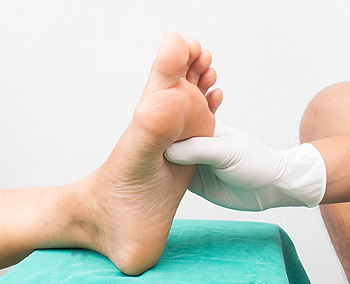Connect With Us
Blog
Items filtered by date: September 2024
Syndesmosis Injury and Ankle Pain

A syndesmosis injury involves the ligament connecting the tibia and fibula, which are the two main bones of the lower leg just above the ankle. This ligament plays a key role in maintaining stability in the ankle joint. Damage often happens when the foot twists outward in relation to the leg, commonly known as an external rotation injury. Syndesmosis injuries typically occur at the same time as ankle sprains or fractures. Symptoms include pain above the ankle, calf pain, and difficulty bearing weight. Proper diagnosis might involve X-rays or advanced imaging techniques to assess the stability of the joint. Severe cases may require surgery to realign and stabilize the joint. A podiatrist can provide both diagnostic clarity and treatment options, from conservative care to surgical intervention. If you have ankle pain related to the ligaments in your lower leg, it is suggested that you make an appointment with a podiatrist for an exam, diagnosis, and treatment options.
Ankle pain can be caused by a number of problems and may be potentially serious. If you have ankle pain, consult with Darlyne Cange, DPM from Cange Podiatry, DPM, PA. Our doctor will assess your condition and provide you with quality foot and ankle treatment.
Ankle pain is any condition that causes pain in the ankle. Due to the fact that the ankle consists of tendons, muscles, bones, and ligaments, ankle pain can come from a number of different conditions.
Causes
The most common causes of ankle pain include:
- Types of arthritis (rheumatoid, osteoarthritis, and gout)
- Ankle sprains
- Broken ankles
- Achilles tendonitis
- Achilles tendon rupture
- Stress fractures
- Bursitis
- Tarsal tunnel syndrome
- Plantar fasciitis
Symptoms
Symptoms of ankle injury vary based upon the condition. Pain may include general pain and discomfort, swelling, aching, redness, bruising, burning or stabbing sensations, and/or loss of sensation.
Diagnosis
Due to the wide variety of potential causes of ankle pain, podiatrists will utilize a number of different methods to properly diagnose ankle pain. This can include asking for personal and family medical histories and of any recent injuries. Further diagnosis may include sensation tests, a physical examination, and potentially x-rays or other imaging tests.
Treatment
Just as the range of causes varies widely, so do treatments. Some more common treatments are rest, ice packs, keeping pressure off the foot, orthotics and braces, medication for inflammation and pain, and surgery.
If you have any questions, please feel free to contact our offices located in Glen Burnie and Ellicott City, MD . We offer the newest diagnostic and treatment technologies for all your foot care needs.
Treat Your Feet to a Medical Pedicure
Essential Tips for Daily Diabetic Foot Care

Proper daily care is essential for managing diabetic foot health and preventing complications. Begin by inspecting your feet each day for any cuts, blisters, or changes in skin color, as diabetes can reduce sensation and delay healing. Wash your feet daily with mild soap and water, making sure to dry them thoroughly, especially between the toes, to prevent fungal infections. Moisturize your feet with a thick, non-irritating cream to combat dryness, but avoid applying lotion between the toes. Wear well-fitting, supportive shoes to prevent pressure sores and blisters. Avoid walking barefoot to reduce the risk of injury, and regularly trim toenails straight across. If you have diabetes and it is affecting your feet, it is strongly suggested that you are under the care of a podiatrist who can help you to manage this serious condition.
Diabetic foot care is important in preventing foot ailments such as ulcers. If you are suffering from diabetes or have any other concerns about your feet, contact Darlyne Cange, DPM from Cange Podiatry, DPM, PA. Our doctor can provide the care you need to keep you pain-free and on your feet.
Diabetic Foot Care
Diabetes affects millions of people every year. The condition can damage blood vessels in many parts of the body, especially the feet. Because of this, taking care of your feet is essential if you have diabetes, and having a podiatrist help monitor your foot health is highly recommended.
The Importance of Caring for Your Feet
- Routinely inspect your feet for bruises or sores.
- Wear socks that fit your feet comfortably.
- Wear comfortable shoes that provide adequate support.
Patients with diabetes should have their doctor monitor their blood levels, as blood sugar levels play such a huge role in diabetic care. Monitoring these levels on a regular basis is highly advised.
It is always best to inform your healthcare professional of any concerns you may have regarding your feet, especially for diabetic patients. Early treatment and routine foot examinations are keys to maintaining proper health, especially because severe complications can arise if proper treatment is not applied.
If you have any questions please feel free to contact our offices located in Glen Burnie and Ellicott City, MD . We offer the newest diagnostic and treatment technologies for all your foot and ankle needs.
The Connection Between Foot Pain and Hypothyroidism

Foot pain can often be a hidden symptom of hypothyroidism, a condition where the thyroid gland does not produce enough hormones. Hypothyroidism can lead to various complications, including peripheral neuropathy and fluid retention, both of which contribute to foot discomfort. Poorly controlled thyroid levels can cause nerve damage, resulting in tingling, numbness, or pain in the feet. Additionally, hypothyroidism often leads to fluid retention, causing swelling in the feet and ankles, which can increase foot pain. The reduced metabolic rate associated with thyroid dysfunction can also affect muscle strength and joint health, further contributing to foot issues. If you have a thyroid condition and are experiencing foot pain, it is suggested that you consult a podiatrist who can treat various foot ailments, in addition to determining if it is linked to thyroid disease.
When dealing with systemic disease of the feet, it is extremely important to check the affected areas routinely so that any additional problems are caught quickly. If you have any concerns about your feet and ankles contact Darlyne Cange, DPM from Cange Podiatry, DPM, PA. Our doctor will assist you with all of your podiatric needs.
Systemic Diseases of the Feet
Systemic diseases affect the whole body, and symptoms usually are displayed in the feet. This condition can make a patient’s ability to walk unbearable. Systemic diseases include gout, diabetes mellitus, neurological disorders, and arthritis.
Gout – is caused by an excess of uric acid in the body. Common symptoms include pain, inflammation, and redness at the metatarsal/phalangeal joint of the base big toe. Gout can be treated by NSAIDs to relieve pain and inflammation, and other drugs that lower the acid levels in the body.
Diabetes mellitus – is an increase in the level of blood sugar that the body cannot counteract with its own insulin. Failure to produce enough insulin is a factor in Diabetes.
Diabetes of the Feet
Diabetic Neuropathy – may lead to damaged nerves and affect the feet through numbness and loss of sensation.
Peripheral Vascular Disease – can restrict the blood flow to the feet, and often times lead to amputation of the feet.
If you have any questions please feel free to contact our offices located in Glen Burnie and Ellicott City, MD . We offer the newest diagnostic and treatment technologies for all your foot and ankle needs.

